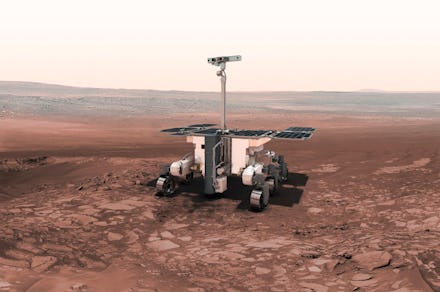Evidence of life on Mars may have already been found in the ‘70s

As the hunt continues to find evidence of life on Mars, one former NASA researcher believes we may have already found it — then dismissed it. In a blog post for Scientific American, Dr. Gilbert V. Levin maintains his belief that the results from a mission to Mars in 1976 should have spurred follow-up studies to investigate what appeared to be organic material. Instead, NASA has focused on whether the planet 'could have' had life rather than whether it currently does.
The 1976 Viking mission to Mars, the first mission to successfully land two space probes on the red planet, included a life-detection experiment called Labeled Release (LR). Dr. Levin was the principal investigator of the LR study, which took samples of Martian soil and infused them with drops of nutrients. If organic microbes existed in the soil, the researchers hypothesized, they would ingest the nutrients and release CO2 gas. The gas would then be evidence of a living organism with a metabolism.
To prove the gas was the result of organisms and not just a chemical reaction from the soil, the control samples of soil would be heated and given nutrients like the Martian samples. The scientists presumed that the heat would kill any microorganisms and wouldn't produce any gas after being given nutrients.
Both the experiment and the control groups worked as predicted, noted CNN. However, after initially detecting traces of gas after the first infusion of nutrients, the LR study was unable to repeat the reaction with the same samples of soil. The first injection of nutrients would result in gases released, but the second or third injections wouldn't. This led researchers to believe the results were 'inconclusive' and not indicative of life on Mars.
Dr. Levin has contested this conclusion and continues to believe the initial results indicated evidence of life on Mars. He thinks the measuring instruments they used in the '70s weren't sensitive enough to pick up what might have been traces of metabolized gases.
"Life on Mars seemed a long shot," Dr. Levin writes in his op-ed. "On the other hand, it would take a near miracle for Mars to be sterile." Given how scientists have even found living microorganisms in the cold space outside the International Space Station, he finds it harder to believe there's no life at all. "What is the evidence against the possibility of life on Mars? The astonishing fact is that there is none."
Decades after the Viking mission, other scientists have joined his skepticism over the 'inconclusive' results. They've proposed possible explanations — the chemicals used on the samples could have destroyed microorganisms, for example — while generally reaching the same conclusion: that more research is necessary.
"[L]aboratory studies have shown that some terrestrial microorganisms could survive and grow on Mars," continues Dr. Levin. He asks for NASA to consider including another life detection study with their next Mars mission in 2020. An updated follow-up to the Viking study is needed to better understand and explore Mars.
"Our nation has now committed to sending astronauts to Mars," says Dr. Levin. "Any life there might threaten them, and us upon their return. Thus, the issue of life on Mars is now front and center."